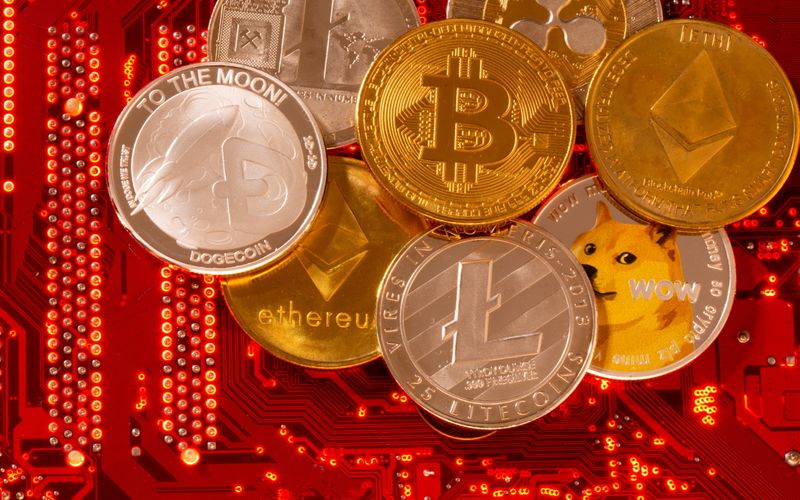
By Marco Oehrl
Investing.com – For crypto investors, 2022 will go down as a year to forget, and quickly. From a technology perspective, the industry made strides with major milestones such as the conversion from Proof-of-Work (PoW) to Proof-of-Stake (PoS), but price-wise, the major cryptocurrencies were on a never-ending slide.
A long, rough ride for crypto triggered by a sharp rise in interest rates
plunged from the $48,000 range to $33,000 in the first three weeks of the year. However, the subsequent recovery was not the beginning of a rally to a new all-time high, but merely a bear market correction from the preceding pullback.

The main thing that hurt BTC and other cryptocurrencies was that more and more central banks were forced to take meaningful action against rampant inflation, with the Fed leading the way. Fed Chairman Jerome Powell already announced in Q4 2021 that inflation could no longer be called transitory, meaning the era of cheap money will soon be over. The mere thought of this froze many financial markets.
What followed was something the markets had thought impossible, because there had not been such rapid in 40 years. While the Fed Fund Rate was still at 0.25 percent at the beginning of the year, it reached 4.50 percent on December 14, 2022, a 15-year high.

Crypto’s self-inflicted wounds
While the shift in monetary policy changed the rules of the game for financial markets in a fundamental way, the crypto market also had to contend with one homegrown scandal after another.
Blockchain technology, which was so highly praised and touted as secure, proved to be a suitable target for digital heists on several occasions due to human error. Fraudsters and hackers may have had one of their most successful years, as the amount they were able to take from users in the crypto sector reaches billions of dollars.
And as if that wasn’t enough to keep new investors away from this industry, some of the dazzling icons of the digital business turned out to be rotten eggs.
The blockchain kicked things off with its founder Do Kwon. Despite warnings against the idea, he chose to establish a stablecoin called , pegged to the value of the . But instead of backing this with adequate dollar reserves, he chose the cheaper route of using an algorithmic stablecoin. Traders could not sell a TerraUSD for one dollar, but instead received worth one dollar.
TerraUSD was used on crypto lending platforms like Anchor Protocol to earn whopping returns. Up to 20% was possible, which sounded tempting not only for individual crypto investors in times of low interest rates, but also for institutional investors who forgot about the risks that come with high returns and even increased them by bringing leverage into play.

Source: Medium
In early May, the house of cards supporting the stablecoin began to falter and then collapsed completely. To date, it has not been clarified what the actual cause was. What is certain is that billions of dollars disappeared into thin air, as did the founder Do Kwon – who is still wanted by Interpol.
One More Scandal – FTX
While thousands of retail investors had their dreams of quick crypto riches dashed, some of the troubled projects survived. FTX founder Sam Bankman-Fried (SBF) rushed to their aid. He distributed or invested hundreds of millions of dollars in the industry, preventing a bankruptcy domino effect and gaining a reputation as something like a crypto-age JPMorgan.
At that point, all players in the market assumed that FTX and SBF were the rock of the industry. A permanent fixture in the sector, pulling the cart out of the mud in times of crisis.
But less than 6 months later the tide turned, and SBF and FTX experienced their own very personal Armageddon.
It started with Binance founder Changpeng Zhao (CZ) accusing SBF of lobbying for policies that hurt the rest of the crypto industry. He announced that he would sell his holdings in , as he no longer had faith in FTX’s balance sheet. This had the effect of withdrawing his support from SBF as well.
This was the starting shot of a bank run on FTX, forcing the crypto exchange to suspend payouts due to a lack of liquidity. The FTX token rapidly lost value and it came to light that FTX had misappropriated and taken customer funds to finance other business lines.
Binance and FTX then came to a memorandum of understanding in which Binance would take over FTX’s business. While this calmed the situation in the short term, it also led to accusations that this had been CZ’s intention from the beginning.
But when it became clear that the capital hole that needed to be plugged was $10 billion, CZ pulled out of the potential deal. As a result, the entire crypto market collapsed and bitcoin hit a new cycle low at $15,500. The crypto sector had now squandered its last remaining shred of confidence.
In the last chapter of the cryptocurrency sector’s sad 2022 story, SBF was arrested in the Bahamas and extradited to the US. There, he will face trial with the potential for a long prison sentence for fraud if found guilty. Business partners Caroline Ellison and Gary Wang have already turned on SBF and are cooperating with the SEC.
While SBF’s story as an industry player looks likely to be over, what the next chapter for cryptocurrency as a whole is remains to be seen. It is hard to imagine it could get much worse than 2022.
This news is republished from another source. You can check the original article here



